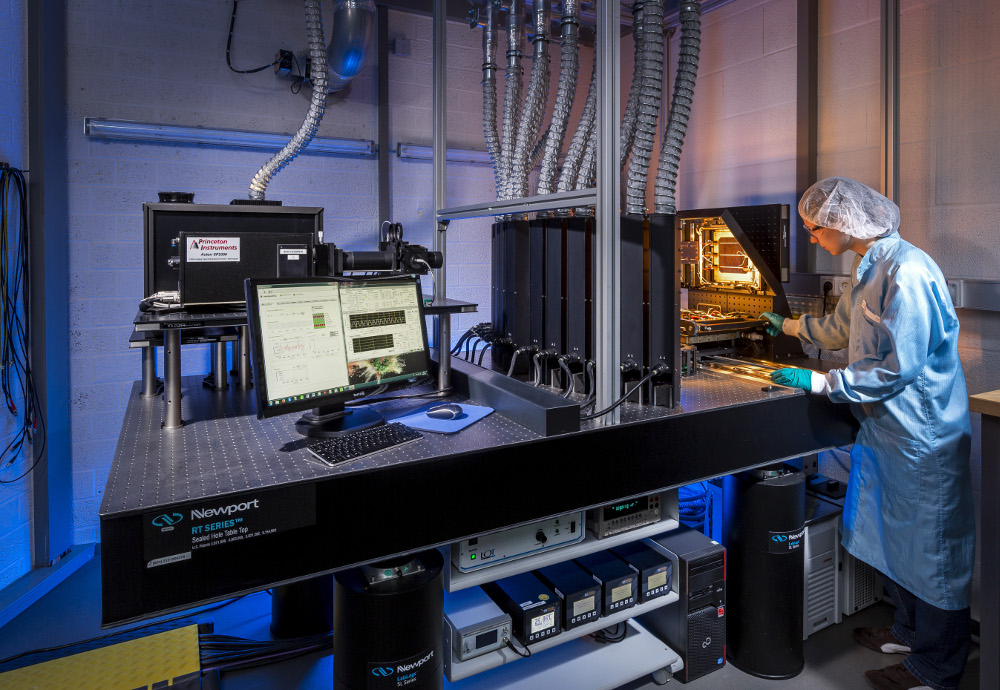ISFH CalTeC – Solar cells
Contact
Dr. Karsten Bothe
Tel.: +49(0)5151-999 425
E-Mail: solarcells@caltec.isfh.de
Area measurement system based on a calibrated high resolution document scanner.

Setup for the measurement of the current voltage characteristic

Differential spectral response (DSR) measurement setup
Solar cell calibration
The solar cell calibration laboratory is part of the ISFH Calibration and Test Center (ISFH CalTeC). It is accredited for the calibration of solar cells by the national accreditation body of the Federal Republic of Germany DAkkS (Deutsche Akkreditierungsstelle) under the registration number D-K-18657-01-00. The accreditation confirms that ISFHf CalTeC fulfils the ‘General requirements for the competence of testing and calibration laboratories’ of the International Organization for Standardization as defined in the ISO/IEC 17025 standard.
The scope for certified measurements of solar cells includes:
- The area (A) of the cell or the aperture mask used for the measurements.
- The spectral responsivity (SR) of the cell.
- The characteristic parameters of the current–voltage (I–V) curve (short-circuit current Isc, open-circuit voltage Voc, fill factor FF and power conversion efficiency η).
- The temperature coefficients α (for Isc), β (for Voc) and δ (for Pmax).
All parameters are reported with the accompanied uncertainty following an approved measurement uncertainty analysis. In order to ensure traceability to SI units, all reference devices are calibrated at Physikalisch-Technische Bundesanstalt (PTB) – the National Metrology Institute of Germany.
The calibration service of the ISFH CalTeC focuses on the measurement of wafer-based silicon solar cells from laboratory up to industrial formats. Contacting units for typical 5 busbar solar cells are available as well as contact units for multibusbar (mBB) cells with up to 12 busbars and busbarless (BB0) solar cells. For the latter, measurements on cells with an edge length of up to 166 mm M6 can be performed.
The ISFH CalTeC is listed as a “designated test centres” to confirm solar cell efficiency records for the “Solar cell efficiency tables”. The efficiency tables published in the international journal “Progress in Photovoltaics” (Wiley) list the currently highest independently confirmed efficiencies for solar cells and modules every six months.
Publications
Solar cell efficiency tables (Version 64)
Progress in Photovoltaics: Research and Applications 32(7), 2024, p. 425
The Impact of Measurement Conditions on Solar Cell Efficiency
Solar RRL 8(3), 2024, 2300873
Solar cell efficiency tables (Version 63)
Progress in Photovoltaics: Research and Applications 32(1), 2024, p. 3
Extended FF and Voc Parameterizations for Silicon Solar Cells
IEEE Journal of Photovoltaics 13(6), 2023, p. 787
Solar cell efficiency tables (Version 62)
Progress in Photovoltaics: Research and Applications 31(7), 2023, p. 651
Multi-Spectrum Method for the Determination of the Spectral Responsivity and the Short-Circuit Current of Photovoltaic Devices
Solar RRL 7(13), 2023, p.2300240
Interlaboratory comparison of voltage sweep methods used for the electrical characterization of encapsulated high-efficiency c-Si solar cells
Progress in Phoovoltaics: Research and Applications 31(3), 2023, p. 201
Solar cell efficiency tables (Version 61)
Progress in Photovoltaics: Research and Applications 31(1), 2023, p. 3
Solar cell efficiency tables (Version 60)
Progress in Photovoltaics: Research and Applications 30(7), 2022, p. 687
Interlaboratory Comparison of Voltage Sweep Methods Used for the Electrical Characterization of Encapsulated High-Efficiency c-Si Solar Cells
38th European Photovoltaic Solar Energy Conference and Exhibition, online, (2021), p. 594
Analysis and Correction of Systematic Deviations in Measurements of the Spectral Irradiance of Solar Simulators
38th European Photovoltaic Solar Energy Conference and Exhibition, online, (2021), p. 172
Contacting of Busbarless Solar Cells for Accurate I-V Measurements
37th European Photovoltaic Solar Energy Conference and Exhibition, online, (2020), pp. 277-281
Results of the Bifacial PV Cells and PV Modules Power Measurement Round Robin Activity of the PV-Enerate Project
37th European Photovoltaic Solar Energy Conference and Exhibition, online, (2020), pp. 877-882
Precise and accurate solar cell measurements at ISFH CalTeC
Photovoltaics International Volume 43, (2019).
Determining the spectral responsivity of solar cells under standard test conditions
Measurement Science and Technology 30 (12), 125008, (2019).
Interlaboratory comparison of short-circuit current versus irradiance linearity measurements of photovoltaic devices
Solar Energy 182, 256 – 263, (2019).
Results of four European round-robins on short-circuit current temperature coefficient measurements of photovoltaic devices of different size
Solar Energy 179, 424 – 436, (2019).
Results of the round robin calibration of reference solar cells within the PhotoClass project
International Journal of Metrology and Quality Engineering 9 (8), (2018).
Approximating the determination of the spectral responsivity of solar cells
7th World Conference on Photovoltaic Energy Conversion (WCPEC), Waikoloa Village, HI, USA, (2018).
Accuracy of Simplifications for Spectral Responsivity Measurements of Solar Cells
IEEE Journal of Photovoltaics 8 (2), 611-620, (2018).
Impact of contacting geometries on measured fill factors
Energy Procedia 124, 84-90, (2017).
Impact of Contacting Geometries When Measuring Fill Factors of Solar Cell Current-Voltage Characteristic
IEEE Journal of Photovoltaics 7 (3), 747-754, (2017).
Monofacial IV measurements of bifacial silicon solar cells in an inter-laboratory comparison
32nd European Photovoltaic Solar Energy Conference, Munich, Germany, (2016), pp. 915-921.
Contacting interdigitated back-contact solar cells with four busbars for precise current-voltage measurements under standard testing conditions
IEEE Journal of Photovoltaics 2 (3), 247-255, (2012).

